The cell cycle
Refers to the sequence of events which occur between the formation of a cell and its division into daughter cells. The cell cycle has three (3) main stages.
-
Interphase
Interphase is the period of intense synthesis and growth. The cells produce materials required for its own growth and carrying out other functions. Interphase is further divided into:
i.G1 (Gap one) or first growth phase
G1 is a phase which characterized with:
edu.uptymez.com
- Production of mitochondria, chloroplasts (in plant ),lysosomes, ER, Golgi complex, vacuoles etc
- Formation of structural and functional; proteins.
- Production of RNAs
- Ribosomes are synthesized
-
Metabolic rate of the cells becomes very high.
ii.S (synthetic phase)
- DNA synthesis takes place
- Production of histones that cover each DNA strand
-
Chromosomes become as two(2) chromatids
iii. G2 (Gap two)second growth phase
- Centriole replicates
- Mitotic spindle start to form
- Energy store increases
- Intensive cellular synthesis (synthesis of RNA and protein)
edu.uptymez.com
- Mitosis (M) -is the process of nuclear division involving the separation of chromatids and their renglish-swahili/distribution” target=”_blank”>distribution as chromosomes into daughter cells.
- Cell division – is the process of division of the cytoplasm into two (2) daughter cells.
-
Process of mitosis
Mitosis is a continuous process which occurs in four (4) active stages. These stages are the prophase, metaphase and telophase. An intermediate stage the interphase occurs between one cell division and another. The following are mitosis stage in animals
1. Prophase
This is the longest phase of mitosis division. Behavior of the chromosome is as follows;
edu.uptymez.com
- Chromosome appears as pair of chromatids joined by centromere.
- Nuclear membrane tends to disintegrate.
- Nucleoli start to disappearing
- Centrioles move to the opposite pole
-
Microtubules radiate from centrioles called astars.
2. metaphase
- formation of spindle fibres (asters)
- Pairs of chromatids attached to spindle at the centromere.
- Nuclear membrane and nucleoli disappear
-
Chromosomes line up at the equator of the spindle.
3. Anaphase – is a very rapid stage.
- The centromere splits into two (2)
- Daughter centromeres are pulled to the opposite sides by spindle fibre.
-
Separated chromatids are now called Chromosomes, are pulled a long behind the centromeres.
4. Telophase
- Chromosomes reach the poles of the cell.
- Chromosomes uncoil, lengthen and form chromatin network.
- Spindle fibres disintegrate. Each centriole then replicates
- Nuclear membrane reappears and nucleoli reappear
-
Leads to cytokitnesis.
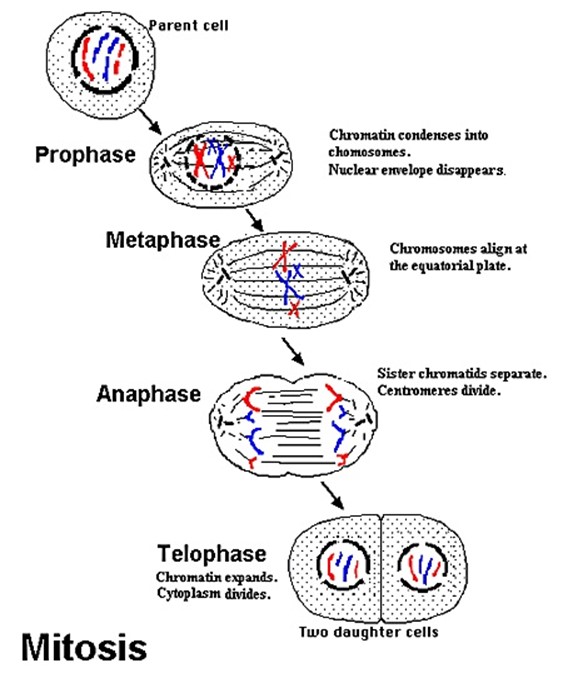
edu.uptymez.com
-
Cell division (cytokinesis.)
Cell division is a process of division of the cytoplasm into two (2) daughter cells. In preparation for division the cells organelles become distributed into the two (2) cells. After the nuclear division (karyokinesis.) the cytoplasm is divided into two (2) (more or less) equal parts. The cytoplasmic division differs in animal and plants cells.
Cytokinesis in animals.
The cells membrane begins to invaginate where spindle equal was present earlier. The cell membranes of opposite ends meet at the centre and cell divides into two (2) daughter cells.
Cytokinesis in plants
In plant cells the spindle fibres do not disappear at the region of equatorial plane, they increase in number and form cell plate across the equatorial plane. As the plate gradually become more distinct and develops into the new cell, it divides the cell in two (2).
Difference between mitosis in plant and animals
edu.uptymez.com
| plants | Animals | |
| 1 | No centriole present. | Centrioles present. |
| 2 | No aster forms. | Aster forms. |
| 3 | Cells plate forms. | No cell plate forms. |
| 4 | No furrowing of cytoplasm at cytokinesis | Furrowing of cytoplasm at cytokines. |
| 5 | Occurs mainly at meristems | Occur in tissues throughout the body. |
edu.uptymez.com
. Significance of mitosis.
-
Growth and development
Mitosis is a basic component of growth as its leads to increase in number of the body cells.
Body repair -the worn-out cells are replaced by the formation of new cells by mitosis.
The newly formed cells by mitosis have opportunity of differentiation forming of complex body.
- Genetic stability
edu.uptymez.com
Mitosis produce the nuclei which have the same number of chromosome as the parent cells more over since these chromosomes were derived from parental chromosomes by exact replication of their DNA,they will carry the same hereditary information in their genes.
In other words , the daughter cells are genetically identical to their parent cells and no variation in genetic information is introduced during mitosis .
- Asexual reproduction
edu.uptymez.com
Many animals and plant species are propagated by asexual method involving the mitotic division of cells alone .
4. Regeneration
The ability of some organism to replace the lost parts of the body such as legs in crustacean is brought about by the action of mitosis.
Seed germination
Germination – is defined as the onset of growth of the embryo in seeds.
Or Germination is the transformation of seed in to a seedling
edu.uptymez.com
Environmental conditions needed for germination.
1. Water
Water is required to activate the biochemical reactions associated with germination. Many biochemical reactions in the germinating seed take place in aqueous solution.
Water is also an important reagent in hydrolyzing the store food. Water enters the seed through the micropyle and the seed coat or testa by process called imbibition.
2. Temperature
For the seed to geminate there are minimum or optimum temperatures required. The temperature for seed germination range from 5 to 40’c. The temperature influences the rate of enzyme controlled reactions.
3. Oxygen
Oxygen is the required for aerobic respiration , the process where food material are oxidized to release energy in the cells .
In cases aerobic respiration can be supplemented with anaerobic respiration.
Physiology of seed germination
Seeds store food materials such as carbohydrates, lipids, proteins, mineral salts and vitamins. The large food reserves in seeds are the lipids and carbohydrates. Starch is the major food reserves of grasses and cereals. Legumes are very rich in proteins.
The food materials are stored in the endosperm in absence of the endosperm food in seeds is stored in the cotyledons of the embryo for this reasons we have endospermic seed and non – endospermic seed
In bean seeds, the cotyledons have been modified for food the storage of food. The stored food is used to provide energy and raw materials for building the tissue before the new seedling is able to photosynthesize.
The events leading to food germination can be summarized as follows
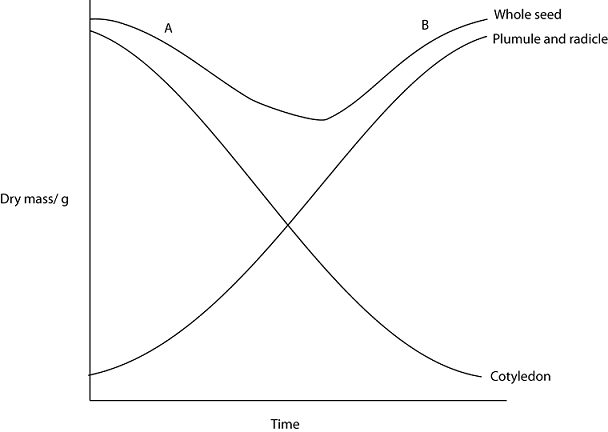
-
The water taken in by imbibitions and osmosis hydrates the food reserves which results into activation of enzymes of respiration. Other enzymes are synthesized possibly using amino acids provided by the digestion of stored proteins.
- Digestion of food reserves hydrolysis .The soluble products of digestion are then translocated to the growth regions of the embryo.
-
Break down of food substrates ( food reserves and the products of digestion) to release energy used in both storage tissue and growing embryo . This involves oxidation of substrate usually sugar to carbon dioxide and water.
Respiration account for loss of dry mass in seeds due to the loss of sugars. Water is not counted in the loss of dry mass as water is excluded in accounting the dry mass. The respiration rates in both endosperms or other storage tissue and embryo are high owing to the intense metabolic activity in these regions . The loss in dry mass continues until the seedling produces green leaves and starts to make its own food.
edu.uptymez.com
- The graph below summarize the changes in dry mass of the endosperm and embryo during germination ,
edu.uptymez.com
Types of germination.
There are two types of germination according to whether or not the cotyledons grow above or remain below it.
-
Epigeal germination
This is the type of germination when the cotyledons are carried above the ground. In dicotyledons, the part of the shoot axis or internode just below the cotyledon the (hypocotyl ) elongates carrying the cotyledon above the soil, in epigeal germination the hypocotyle remains hooked as it grows through the soil , meeting the resistance of soil rather than the delicate plumule tip which is further enclosed and protected by cotyledon. The hypocotyl strengthens immediately on exposure to sunlight.
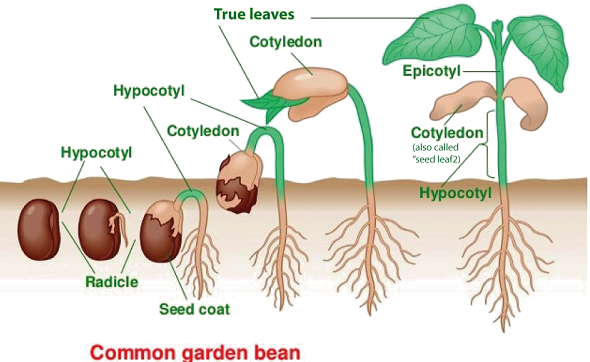
edu.uptymez.com
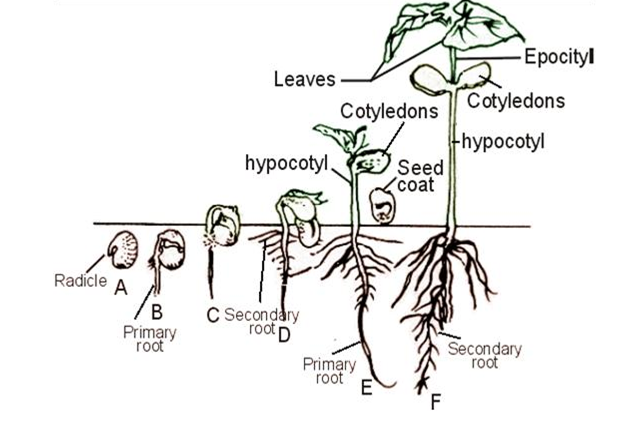
- Hypogeal germination
edu.uptymez.com
This is the type of germination where cotyledons remain below the ground. The internode just above the cotyledons ( the epicotyl) elongates and therefore the cotyledons remain below the ground. In hypogeal germination of
dicotyledons the epicotyledons is hooked to protect the plumule tip .it immediately straightens on exposure to sunlight. In grasses which are monocotyledons, the plumule is protected by a sheath called coleptile. The first leaf
grow out through coleptile and unrolls response to light.
GROWTH OF THE EMBRYO
The first sign of the embryo growth is the emergence of the embryonic root, (the radical).This grows down and anchors the seed. The radical is positively geotropic.
Then it follows the emergence of the plumule which grows upward and it is positively phototrophic.
Primary and secondary growth in flowering plants.
With exception of the young embryo, growth in plants is confined to certain regions known as meristems .
Growth in plants is said to be localized i.e. confined to specific regions such as root and shoot tips.
Meristems
A meristem is a group of cells which retain the ability to divide by mitosis, producing the daughter cells which grow and form the rest of the plant body. The cells that have lost the ability to divide form the permanent tissue.
Meristems are also known as initials. There are three types (3) of initials. The classification is based on their location. These include:
-
Apical meristems
This is a type of meristem located in the root and shoot apex. They are responsible for primary growth, giving rise to primary plant body. The effect of apical meristem is to cause increase in length.
-
Lateral meristems (the cambium.)
These are laterally situated in older parts of plants parallel with long axis of organs E.g. cork cambium (phellogen) and vascular cambium. They are responsible for secondary growth. Vascular cambium gives rise to
secondary vascular tissues, phellogen gives rise to the periderm which replaces the epidermis and includes cork. The Effect of lateral meristem is to cause increase in girth.
-
Intercalary meristems.
These are found between regions of permanent tissues E.g. at nodes of many monocotyledonous plants in the bases of grass leaves. Intercalary meristems allow growth in length to occur in regions other than tips. This is
very useful if the tips are susceptible to damage or destruction. E.g. being eaten by herbivores. Branching from the main axis is not then necessary.
edu.uptymez.com
Types of growth in plants.
- Primary growth – This is the first form of growth which results into the plant increasing in length. This is the only type of growth occurring in most monocotyledonous plants and herbaceous dicotyledonous. Primary growth is a result of the activity of the apical and sometimes intercalary meristems.
-
Secondary growth
This is the growth which occurs after primary growth as a result of lateral meristems characterized by deposition of new phloem and large amount of secondary xylem called wood. Secondary growth results into increase in girth. Secondary growth is a characteristic feature of trees and shrubs. A few herbaceous plants show restricted amount of secondary thickening.
-
Primary growth
Primary growth in shoots.The shoots apex can be distinguished into four (4) regions. These are the regions of cells division, region of cell elongation, region of cell differentiation and region of permanent tissue. The cells become progressively older as you move from the apical meristems.
edu.uptymez.com
The region of cell division.
The apical meristem is dome shaped. The meristems cells are distinguished into the protoderm, which give rise to the epidermis, the ground meristems which produce parenchyma ground tissues which form the cortex and pith in dicotyledons, and the procambium which gives rise to the vascular tissues, including pericycle, phloem, vascular cambium and xylem.
Characteristics of Apical meristems
- The cells are relatively small, cuboids with thin cellulose wall and dense cytoplasm content.
- They have few small vacuoles.
- They are packed tightly together with no obvious air space between cells.
- They lack chloroplasts’.
- When they divided by mitosis, one daughter cell remains in the meristem while others increase in size and differentiate to become part of permanent plant body.
edu.uptymez.com
Zone of expansion or cells elongation.
The daughter cells produced by initials increase in size mainly by osmotic uptake of water into these cells. Increase length of stems and root is mainly brought about by elongation of cells during this stage.
The expansion of cells in addition is due to thickening of the cell wall either by cellulose or lignin depending on the type of cell being formed.
Zone of cells differentiation
The process of differentiation is initiated from the procambium. This gives rise to the protoxylem in the inside and protophloem on the outside which are part of the primary xylem and primary phloem respectively. Between the xylem and phloem, there are cells that retain the ability to divide. They form the vascular cambium.
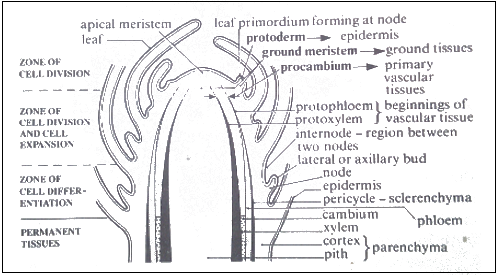
Diagram of shoot tip showing apical meristem
Formation of leaves and Lateral buds.
Growth and development of the shoot also includes growth of leaves and lateral buds. Leaves arise from small swellings or ridges containing groups of meristematic cells.
These swellings or ridges are called primordial. The primordial appear at regular interval, the side of origin being called nodes and the region between the internodes.
The nodes can be arranged in specific pattern or arrangement on the stem. E.g. As whort, singly or spirally. The primordial elongates rapidly, as a result, it soon encloses and protects the apical meristems both physically and by
heat they generate in respiration. They later grow and increase in area to form the leaf blade.
The Lateral bud (auxiliary bud)
These are small groups of meristematic cells which normally remain dormant but retain the capacity to divide and grow at later stage. They form branches or specialized structures such as flowers. Lateral buds also form
underground structure such as Rhizomes and tubers.
They are under control of apical meristems. The lateral buds develop in the axis of the leaves and stem.
Primary growth in roots.
The growth region of the root is distinguished into:
-
The root cap.
The root cap forms the outside of the apical meristems. It is made up of the parenchyma cells. It protects the apical meristems as the roots grow through the soil. The cells of the root cap are constantly being worn away and replaced. The outer layer of the root cap has mucilage which makes it slimy in order to reduce friction. The root cap also has the important additional function of acting as gravity sensors.
-
The zone of cells division.
The zone of cells division is distinguished into the following:
- The quiescent centre
edu.uptymez.com
This forms the very tip of the apical meristems. The quiescent centre is composed of group of initials (meristematic cells) from which all other cells in the root originate. The cells in the quiescent centre has lower rate of cells division in comparison with the surrounding daughter cells.
b) The protoderm ground meristems and procambium.
These are different types of the apical meristems which follow below the quiescent centre. The functions of these cells are the same as the in shoots.
The protoderm form the epidermis, the ground meristems form the cortex, including endoderm and the procambium which form primary phloem, vascular, primary xylem, pith and the pericycle if present. The procambium in roots is used to describe the central cylinder in roots.
-
The zone of cells Elongation.
As in shoot the zone of cell division is followed by a zone of cell elongation. Growth in this region is brought by cell elongation due to osmotic uptake of water in the cytoplasm and then into the vacuole. The zone of elongation cells extends to about 10mm behind the root tip. The increase in length of these cells forces the root tip down through the soil.
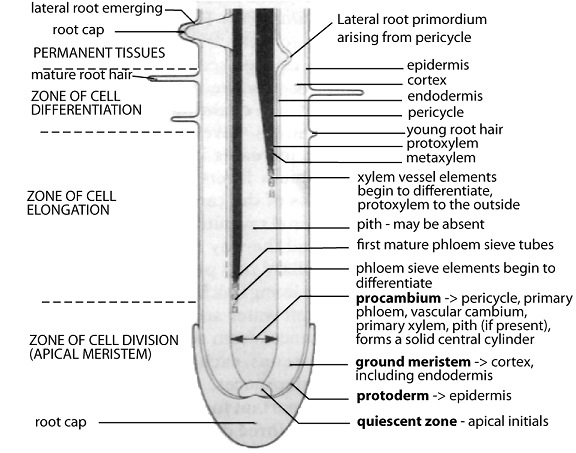
edu.uptymez.com
Diagram of Root tip showing apical meristem
-
The zone of cells differentiation
This is a zone where each cells became fully specialized for its own particular function. In this region the phloem sieve element begin to differentiate. The development of phloem is from outside inward and become progressively more mature further back from the root tip.Xylem starts differentiating further back in the same manner as phloem that is from outside inwards (exarch xylem). The first to differentiate are the xylem
vessels, starting with the protoxylem vessels which transform into the metaxylem and later into mature xylem. The xylem in roots spreads to the centre of the root in which case no pith develops. Further differentiation in this region includes the development of the root hairs from the epidermis .
Formation of lateral root of adventitious root and adventitious
buds.
Lateral roots : These are roots that arise from the main root formed by the resuming of the meristematic activity of the pericycle cells . This is in contrast to the formation of the buds in the shoot.
In the root a small group of the pericycle cells in the zone of differentiation resume meristematic activity and forms a new root epical meristem which grows forcing its way out through the endodermis , cortex and epidermis.
Adventitious roots and buds – Adventitious are those growing in uncharacteristic position formed by a certain cells resuming meristematic activity . Examples are the adventitious buds and roots.
edu.uptymez.com
- Adventitious roots – they develop independently of the original primary root and form the main rooting system of monocotyledons arising from the nodes on stem.
- Adventitious roots are important in the propagation of plants by stem cutting. Some plants like Ivy use adventitious root to cling.
- Adventitious buds –adventitious buds may develop on roots, steam or leaves. In trees can develop new branches adventitiously from buds arise in the trunk.
edu.uptymez.com
2) Secondary growth
This is the growth which occurs after primary growth as a result of the activity of lateral meristems .Secondary growth results in an increase in girth. It is associated with deposition of large amount of xylem called wood. The wood gives charactestic feature of trees and shrubs. Secondary growth is brought about by two (2) types of lateral meristems the vascular cambium which give rise to new vascular tissue cork cambium or phellogen which arises later to replace the ruptured epidermis of expanding plant body .
The activity of the vascular cambium.
There are two types of cells in the vascular cambium these are;
a) The fusiform initials. These are narrow , elongated cells which divide by mitosis to form secondary phloem to the outside or secondary xylem to the inside . The xylem material produced exceeds the amount of phloem.
b) Ray initials
These are almost spherical in shape and divide mitotically to form parenchyma cells. Parenchyma accumulates to form rays between neighboring xylem and phloem.
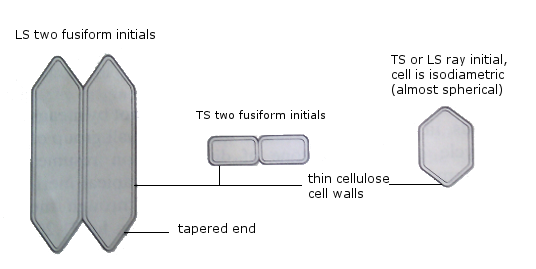
Diagram of Fusiform and Ray initials
Secondary growth in woody dicotyledonous stem
Secondary growth or thickening in stem is brought about by deposition of large quantity of secondary xylem and lesser quantities of secondary phloem by fusiform initials of the vascular cambium.
The vascular cambium is originally located between the primary xylem and primary phloem of the vascular bundles. This is called lutoa fascular cambium. The vascular bundles of dicotyledonous stems are arranged in form of a ring. When the primary xylem and primary phloem are first differentiated, there is no cambium across the pith or a medullary ray which lies in between the edges of the cambium within the bundles divide accordingly and form a layer of cambium across the medullary rays.The newly formed cambial strip which occurs between the gaps in the bundles is called interfaxular cambium. I.e. the cambium in between the two (2) vascular bundles. The complete cambium ring is formed.
The formation of secondary xylem and secondary phloem.
The cambial layer consists of essentially one layer of cells. These cells divide in a direction parallel with epidermis.
Each time a cambial cell divides into two, one of the daughter cells remains merstematic, while the other is differentiated into permanent tissues. If the cell that is differentiated is next to the xylem, it forms xylem while if it next to the phloem it becomes phloem.
The xylem is formed towards the inner side while the phloem towards the outside of the cambium. The cambium cells divide continuously in this manner producing secondary tissues on both sides of it. In this way, new cells are added to the xylem and phloem, and the vascular bundles increase in size.As the stem increase in thickness the circumference of the vascular cambium layer need to increase. This is achieved by radial division of the cambial cells.
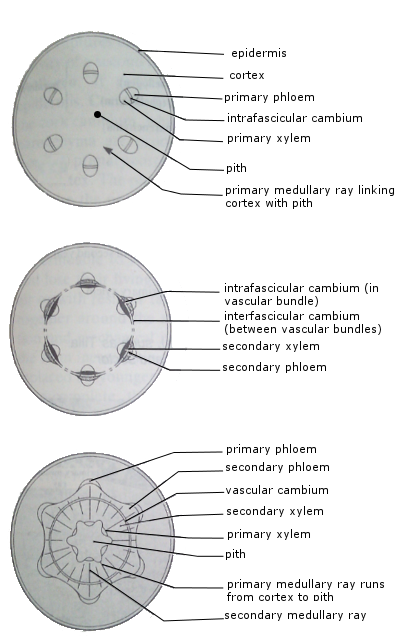
Diagram of Early stages in secondary thickening of typical woody dicotyledon stem.
a. Primary structure of stem.
b. Cambium forms a complete cylinder.
c. a complete ring of a secondary thickening has developed.
Formation of medullary rays.
Medullary rays are formed by ray initials. These are parenchyma four cells that run all the way from the pith or medulla to the cortex.
The pith or medulla forms the central region of the stem of the dicot plant and roots of monocots. The extension of the pith in form of narrow parenchymarous strips are called medullary or pith rays. In some stem the pith is obliterated to form hollow. The medullary rays extend between thee vascular bundles. These are primary and secondary Medullar rays. The primary medullary rays are produced by original ray initials and secondary Medullary rays which are produced by later ray initials.
Function of Medullar rays.
The rays maintain a living link between the pith and cortex. They help to transmit water and mineral salts from xylem and food substance from the phloem rapidly across the stem.
Annual rings.
Annual rings or growth rings refers to the concentric layers of secondary xylem in the stem of the perennial plants each one of which represents a seasonal increment or different phase in deposition of new xylem tissues.
In transverse section of the axis these layers appear as rings and are called annual rings or growth rings. They are commonly termed as annual rings because in woody plants of temperate regions and those of tropical regions, where there is annual alternation of growing and dormant periods each layer represents the growth of one year.
By observing the pattern of annual ring one can pin point the time during which the wood was growing. Dendrochronology is the dating of wood by recognition of pattern of annual rings.
Heart wood and sap wood
The heart wood
This refers to the central region of the old tree where the xylem tissue have ceased to serve as conducting function and become blocked with darkly staining deposits such as tannins, gums, resins and other substance which make it hard and durable. It looks black due to the presence of various substances in it.
Sap wood.
This refers to the outer region of the old trees consisting of recently formed xylem element. This is of light color and some living cells. This part of the stem performs the physiological activities such as conduction of water and nutrients, storage of food.
Cork and lenticels.
Cork (phellogen)
This refers to the tissue formed by activities of a secondary lateral cambium or the Cork cambium to replace the ruptured epidermal cells. It is immediately below the epidermis. The rupturing of the epidermis is a result of increasing circumference of the stem due to outward growth of the secondary xylem.
As the cork cells mature, their walls become impregnated with fatty substance called suberin which is impermeable to water and gases. The cells gradually die and lose their living contents which become filled with either resins or tannins.The cork cells fit together around the stem to prevent dessical infection and mechanical injury.
These are slit- like openings containing mass of loosely packed walled dead cells lacking suberin found at random intervals in the cork. The lenticels are produced by the cork cambium and have large intercellular air space allowing gaseous exchange between the stem and the environment.In the absence of lenticels it would be difficult for gaseous to take place in the stem as the cork which surrounds the stem do not allow air to pass.
Other tissues formed from cork cambium.While the cork (phellem) is produced to the outside of the cork cambium, in the inside one or two (2) layers of parenchyma are produced. These are indistinguishable from the primary cortex and form, the phelloderm or secondary cortex. The phellogen (cork) and phelloderm together comprise the periderm.
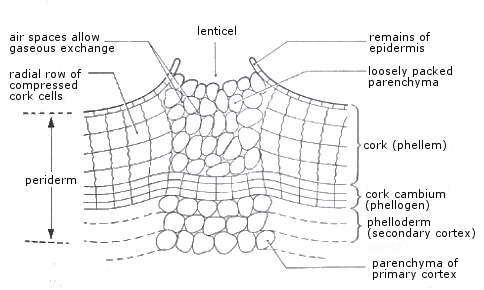
Diagram of lenticel.
The Bark.
The term bark is used to refer either to all the tissue outside the vascular system or strictly to those tissues outside the cork cambium, in either primary or secondary state of growth.
The bark cover the woody stem, peeling bark from a tree generally strips tissue down to the vascular cambium. The bark is composed of dead cells together with the cork layers.